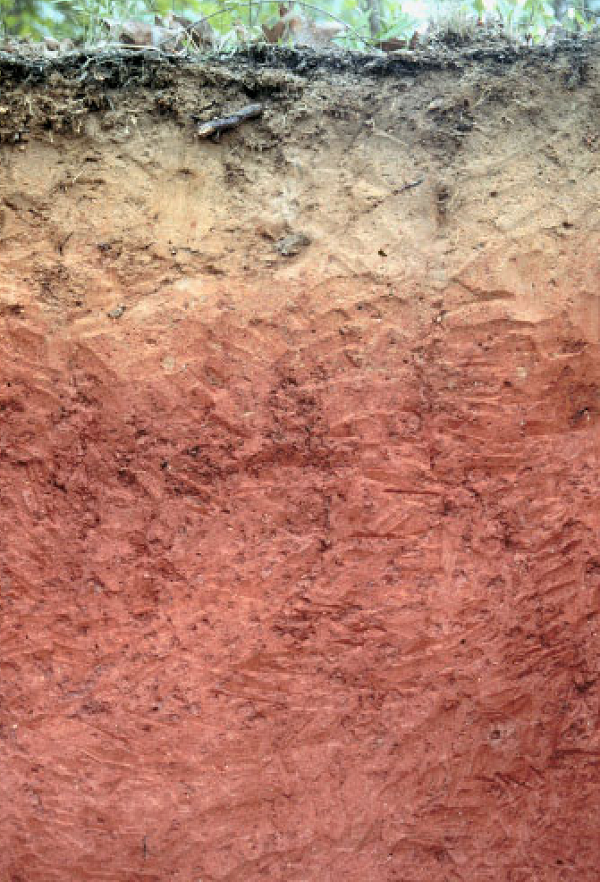Blended Soils

Anything used for agriculture is normally a blend of Clay, Silt, Sand and Rocks.
Clay
Clay have fine particles and is known to hold water longest of all soil types.

Clay holds onto nutrients effectively, and due to the water retention, clay is less susceptible to drought.
Clay may be prone to compaction, can be challenging for root penetration, and may require soil management practices like aeration.
Clay soils lead to bold full-body wines with intense colors.
Grapes:
- Cabernet Sauvignon
- Sangiovese
- Tempranillo
- Carmenere
- Merlot
Best known Regions:
- Burgundy (France)
- Pomerol (Bordeaux, France)
- St. Emilion (France)
- Barolo (Italy)
- Chanti (Italy)
- Rioja (Spain)
- Ribera del Duero (Spain)
- Hillsides in Napa Valley (USA)
- Barossa Valley (Australia)
Clay-based Soils
Clay based soils are cool in temperature and provide good water retention and drainage.
Calcareous
Calcareous Clay is a mix of clay, limestone and chalk that is calcareous, meaning it contains a significant amount of of calcium and magnesium carbonate.

Calcareous clay soils provides good water retention and drainage. They have high limestone content, which neutralizes the acidity (pH) in the soil.
The cool temperatures of the soil normally delay ripening of the grape, which tends to produce more acidic wines.
Grapes:
- Chardonnay
- Pinot Noir
- Grenache
- Syrah
Best known Regions:
- Champagne (France)
- Chablis (Burgundy, France)
- Alsace (France)
- Loire (France)
- Saint-Emilion (france)
- Côtes du Rhône South (France)
- Tuscany (Italy)
Silt
Silt is found in river valleys.
It is a granular material of mineral particles smaller than sand and larger than clay.

Silt is more fertile than sand, hold moisture well, but is prone to compaction (similar to clay), which can affect drainage and aeration. With proper management, silty soils can be suitable for vine cultivation.
Silt produces: Smooth wines with low tannins.
Grapes:
- Pinot Noir
- Grüner Veltliner (Austria)
- Pinot Gris (France)
Best known Regions:
- Washington (USA)
- Willamette Valley (Oregon, USA)
Sand
Sand is found near large bodies of water, like in coastal regions and river valleys.
It is a granular material of mineral particles bigger than silt.

Spiaggia Grande vineyard in Sardinia (Italy) on a sandy soil close to the sea.
Sand can come from any type of rock that has been broken down into small grains.
Sandy soils warm up quickly in the spring, aiding early vine growth. They have good drainage, but can dry out quickly and struggle with water retention. In regions with little rain, sandy soils may require more irrigation.
Sandy soils are one of the few soils that Phylloxera does not thrive in.
Grapes:
- Sauvignon Blanc
- Nebbiolo
- Sangiovese
- Zinfandel
- Malbec
- Verdejo
- Vermentino
- Vernaccia
- Torrontes
Best known Regions:
- Graves (Bordeaux Right Bank, France)
- Médoc (Bordeaux Right Bank, France)
- Cannubi in Barolo (Italy)
- Serralunga d'Alba (Italy)
- Sonoma Coast (USA)
- Lodi in California (USA)
- Barossa Valley (Australia)
- Swartland (South Africa)
Loam
Loam is a combination of sand, silt and clay.

Loam is considered the best soil for almost most any type of plants:
- It is granular
- It retains water
- It have good drainage
- It contains organic matter
Loam can be too fertile for vine grapes that need more difficult soil to struggle with.
Vineyard Loam
The magic of loam is that sandy loam, clay loam, and silt loam make up some of the the greatest wine soils in the world. Sand helps drainage. Clay has nutrients and water-holding capacity. Silt helps with both heat retention and water holding.
Pinot Noir thrives well with this blend in Napa Valley and Sonoma Valley (USA).<(p>

Clay Loam: Higher clay content, retains more moisture

Sandy Loam: Higher sand content, good drainage.
On the picture below, you will see 3 layers of loam:
- Surface is dark brown fine sandy loam
- Subsurface is pale brown fine sandy loam
- Subsoil is red clay loam and sandy clay loam

Source: Wikipedia Commons.
Terra Rossa
Terra Rossa is a red clay-rich soil, with high levels of iron oxide.

Terra rossa soil over white limestone at Coonawarra. © Wine Australia.
Terra Rossa (italian: red soil) is the soil that is left when limestone is broken down. It is a shallow clayey soil with good drainage.
Terra Rossa ocurres in around the Mediterranean and in limited areas of southern Australia.
Best known Regions:
- La Mancha ( Spain)
- Carso and Teran areas in the border region of Slovenia and Italy
- Coonawarra (Australia)
- Barossa Valley (Australia)
Other red iron soil types include Rotliegend in the Rheinfront area of Rheinhessen, and a soil found in the Pomerol area of France with an underlayer of ferruginous clay called "crasse de fer" or "machefer".